Title: Unveiling the Sun’s Mysteries: A Journey with Solar Orbiter
In the vast expanse of space, our closest star, the Sun, has always captivated humanity with its brilliance and mystery. Recently, the veil shrouding some of its enigmatic features was lifted, thanks to the groundbreaking observations made by the Solar Orbiter spacecraft, a mission orchestrated by the European Space Agency (ESA).
The imagery beamed back by this intrepid explorer is nothing short of mesmerizing. Imagine witnessing feathery structures of plasma, akin to delicate lace, dancing across the Sun’s surface. These ethereal formations, dubbed “coronal moss,” adorn the base of colossal magnetic field loops, offering a glimpse into the intricate dynamics of the solar atmosphere.
But the wonders don’t end there. Towering spires of gas, known as spicules, reach staggering heights of approximately 6,000 miles (10,000 kilometers) above the Sun’s chromosphere. These towering structures, reminiscent of celestial skyscrapers, punctuate the solar landscape, adding to its otherworldly allure.
In the midst of this cosmic spectacle, eruptions punctuate the tranquility, lifting cooler material upwards before gracefully descending back to the solar surface. Despite their seemingly modest size relative to the vastness of space, these eruptions dwarf our own planet Earth, serving as a reminder of the Sun’s immense power and influence.
Moreover, the footage reveals a phenomenon known as coronal rain – dark tendrils against the backdrop of blazing coronal loops. Comprised of denser plasma clumps, these ethereal rainfalls cascade back towards the Sun under the relentless pull of gravity, painting a mesmerizing portrait of cosmic ballet.
Yet, beyond the sheer visual splendor, these observations hold profound implications for our understanding of solar physics. One of the most perplexing mysteries surrounding the Sun is the stark temperature differential between its surface and its outer atmosphere, known as the corona. While the Sun’s visible surface boasts temperatures of approximately 10,000 degrees Celsius, the corona blazes at over a million degrees Celsius – a discrepancy that has long baffled scientists.
Enter the concept of “campfires” – miniature flares hypothesized to inject energy into the solar atmosphere, heating it to extreme temperatures. The Solar Orbiter’s unprecedented observations provide tantalizing insights into these elusive phenomena, offering clues to unraveling the mysteries of coronal heating.
Dr. David Long, a solar physicist involved in the mission, describes the thrill of witnessing these celestial phenomena firsthand, emphasizing the constant activity unfolding on the Sun’s surface. As the Solar Orbiter continues its mission, with plans to explore the Sun’s uncharted poles, the stage is set for even more breathtaking discoveries.
With each new revelation, the Solar Orbiter reaffirms humanity’s insatiable curiosity and our relentless pursuit of knowledge, inspiring us to reach for the stars and unravel the mysteries of the cosmos.















































